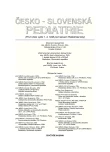„Café-au-lait“ Maculae in the Diagnostics of Child Tumorous Diseases
Authors:
D. Ilenčíková 1,2; D. Ďurovčíková 2; L. Copáková 1; D. Štrbová 1; J. Šuvada 1; A. Rybárová 4; A. Hlavatá 4; K. Wimmer 3
Authors‘ workplace:
Oddelenie onkologickej genetiky, Národný onkologický ústav, Bratislava
primárka MUDr. D. Ilenčíková, PhD.
1; Katedra klinickej genetiky SZU, Bratislava
vedúca doc. MUDr. D. Ďurovčíková, CSc.
2; Oddelenie biológie a genetiky, Viedenská univerzita, Viedeň
vedúca prof. RNDr. Ch. Fonatsch
3; II. Detská klinika LFUK a DFNsP, Bratislava
prednosta prof. MUDr. L. Kovács, DrSc.
4
Published in:
Čes-slov Pediat 2009; 64 (9): 406-414.
Category:
Review
Overview
Café-au-lait maculae are the most frequently associated with neurofibromatosis type 1 disorder. Patients with NF1 develop light- to dark-brown CAL spots with smooth or irregular margins. The diagnosis is confirmed by presence of multiple spots, and at the prepubertal age the finding of six or more CAL maculae larger than 0.5 cm in diameter and at the postpubertal age those larger than 1.5 cm in diameter are required.
However, the finding of hyperpigmentations may represent lots of other genetic or genetically determined disorders. Many of them may predispose to a multiorgan injury or to development of malignancy.
This work describes a group of disorders characterized by CAL maculae that are also associated with:
1. multisystemic affection, 2. inherited diseases and malignances, 3. chromosomal instability syndromes and malignances, 4. neurofibromatosis and malignances, 5. a new syndrome of constitution deficit “ DNA repair system” (CMMR-D). The data about the character of CAL maculae, typical symptoms and type of malignances in individual syndromes serve to improve the differential diagnosis of the tumor disorders in childhood. Molecular diagnostics of germinal mutations may detect very effectively families at high risk for malignancy and help provide primary prevention.
Key words:
café-au-lait, neurofibromatosis type 1, Watson syndrome, NF like, CMMR-D, malignance in childhood
Sources
1. Schepper S, Haeghen YV, Messiaen L, et al. Café-au-lait spots in neurofibromatosis type 1 and in healthy control individuals: hyperpigmentation of a different kind? Arch. Dermatol. Res. 2006;297: 439–449.
2. Korf B. Statins, bone, and neurofibromatosis type 1. BMC Medicine 2008;6: 22.
3. Digilio MC, Sarkozy A, de Zorzi A, Pacileo G, Limongelli G, Mingarelli R, Calabro R, Marino B, Dallapiccola B. LEOPARD syndrome: clinical diagnosis in the first year of life. Am. J. Med. Genet. 2006;140: 740–746.
4. Friedman JM. Epidemiology of neurofibromatosis type 1. Am. J. Med. Genet. 1999 Mar 26;89(1): 1–6.
5. Allanson JE, Upadhyava M, Watson GH, et al. Watson syndrome: is it a subtype of type 1 neurofibromatosis? J. Med. Genet. 1991 November;28(11): 752–756.
6. Brems H, Chmara M, Sahbatou M, et al. Germline loss-of function mutations in SPRED1 cause neurofibromatosis 1-like phenotype. Nature Genetics 2007;39(9): 1120–1126.
7. Patel U, Simpson E, Kingswood JC, et al. Tuberose sclerosis complex: analysis of growth rates aids differentiation of renal cell carcinoma from atypical or minimal-fat-containing angiomyolipoma. Clin. Radiol. 2005;60(6): 663–664.
8. Hirsch B, Shimamura A, Moreau L, et al. Association of biallelic BRCA2/FANCD1 mutations with spontaneous chromosomal instability and solid tumors of childhood. Blood 2004;103(7): 2554–2559.
9. Taniguchi T, D’Andrea AD. The molecular pathogenesis of Fanconi anemia: recent progress. Blood 2006;107: 4223–4233.
10. Seemanová E, Mišovicová N, Schindler D. Louis-Barové syndrom (ataxia teleangiectasia) v konsanguinní rodině. Čes.-slov. Pediat. 2006;61(11): 666–668.
11. Ball LG, Xiao W. Molecular basis of ataxia telangiectasia and related diseases. Acta Pharmacol. Sin. 2005;26(8): 897–907.
12. Amor-Guéret M. Bloom syndrome, genomic instability and cancer: the SOS-like hypothesis. Cancer Lett. 2006;236(1): 1–12.
13. Wimmer K, Etzler J. Constitutional mismatch-repair deficiency syndrom: Have we so far seen only the tip of an iceberg? Hum. Genet. 2008;124(2): 105–122.
14. De Vos M, Hayward BE, Charlton R, et al. PMS2 mutations in childhood cancer. Journal of the National Cancer Institute 2006;98(5): 358–362.
15. Tan TY, Orme LM, Lynch E, et al. Biallelic PMS2 mutations and a distinctive childhood cancer syndrome. J. Pediatr. Hematol. Oncol. 2008;30(3): 254–257.
16. Ďurovčíková D. Neurofibromatosis typ 1 ochorenie multidisciplinárneho charakteru. Revue Mediciny v Praxi 2008;6(4): 10–12.
17. Bandipalliam P. Syndrome of early onset colon cancers, hematologic malignancies & features of neurofibromatosis in HNPCC families with homozygous mismatch repair gene mutations. Fam. Cancer 2005;4(4): 323–333.
18. Felton KE, Gilchrist DM, Andrew SE. Constitutive deficiency in DNA mismatch repair: is it time for Lynch III? Clin. Genet. 2007;71(6): 499–500.
19. Krüger S., Kinzel M., Walldorf C, et al. Homozygous PMS2 germline mutations in two families with early-onset haematological malignancy, brain tumours, HNPCC-associated tumours, and signs of neurofibromatosis type 1. Eur. J. Hum. Genet. 2008;16(1): 62–72.
Labels
Neonatology Paediatrics General practitioner for children and adolescentsArticle was published in
Czech-Slovak Pediatrics

2009 Issue 9
- What Effect Can Be Expected from Limosilactobacillus reuteri in Mucositis and Peri-Implantitis?
- The Importance of Limosilactobacillus reuteri in Administration to Diabetics with Gingivitis
Most read in this issue
- „Café-au-lait“ Maculae in the Diagnostics of Child Tumorous Diseases
- New Classification of the Disorders of Sexual Development (DSD)
- Antimicrobial Resistance of Uropathogens in Children with Febrile Urinary Tract Infections
- Suggested Instructions for Prevention, Diagnostics and Therapy of Child Obesity
